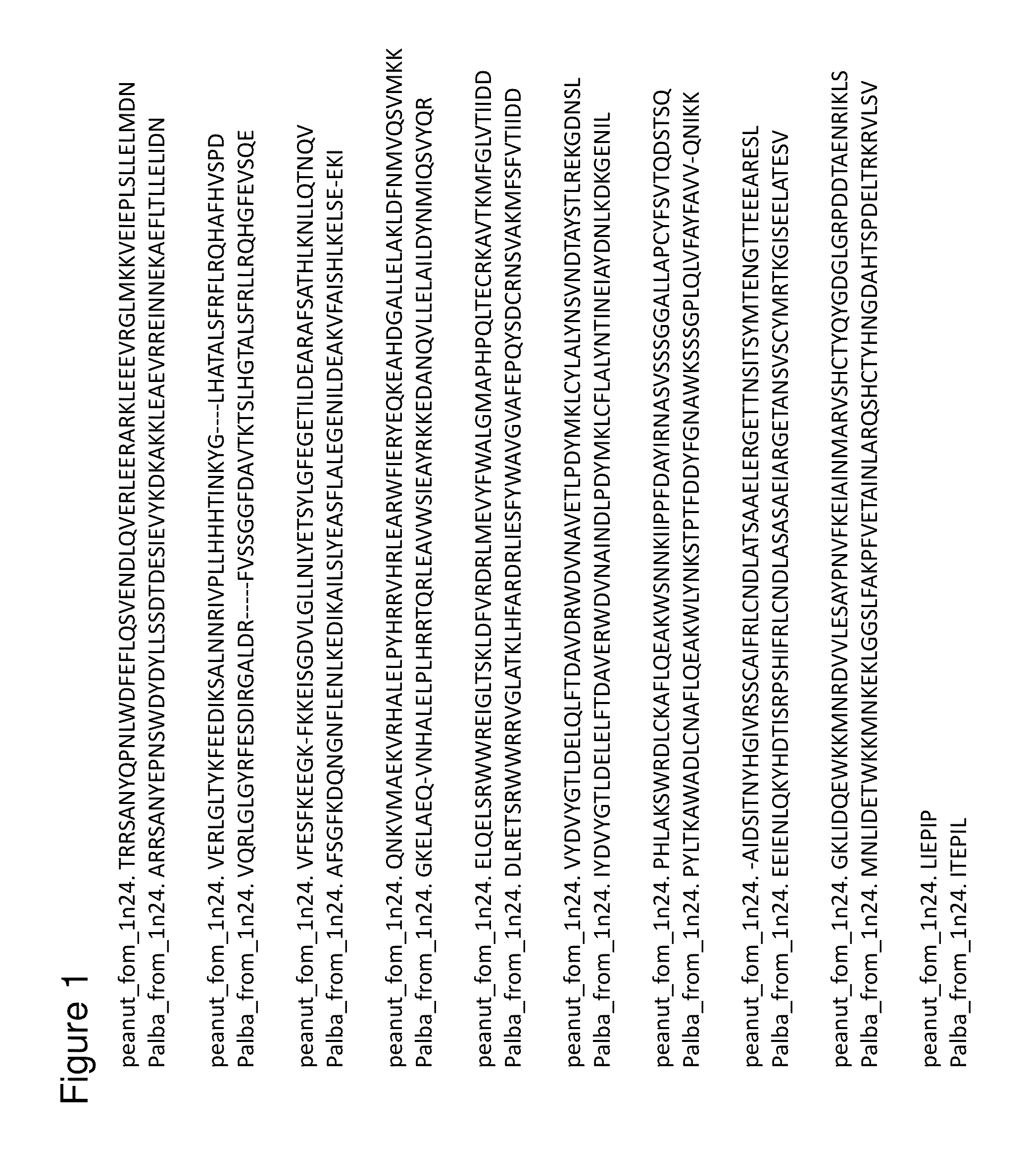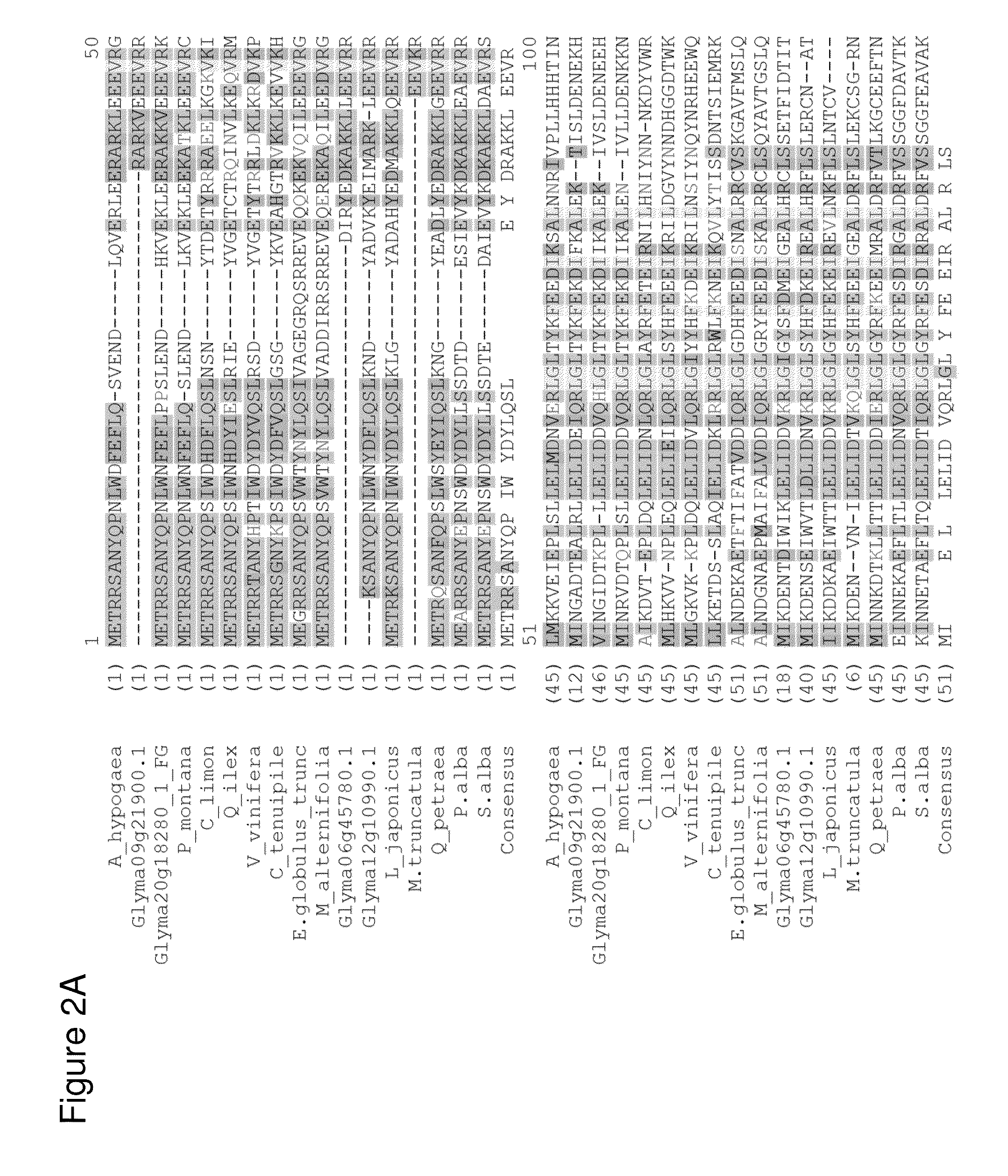Legume isoprene synthase for production of isoprene
a technology of isoprene and synthase, which is applied in the direction of lyases, carbon-oxygen lyases, peptide sources, etc., can solve the problems of limited commercial use of some isps enzymes, insufficient enzymes and even some recombinant enzymes for commercial production of isoprene in biological hosts, etc., to achieve the effect of increasing isoprene production and improving production properties
- Summary
- Abstract
- Description
- Claims
- Application Information
AI Technical Summary
Benefits of technology
Problems solved by technology
Method used
Image
Examples
example 1
Identification of Candidate Isoprene Synthases
[0301]Amino acid sequences encoding isoprene synthase (IspS) isolated from P. alba and P. montana were analyzed against proprietary and public sequence databases to identify polypeptides that may have isoprene synthase activity. Screening criteria for identifying candidate polypeptides with potential isoprene synthase activity included: 1) the presence of one or more immutable amino acid residue(s) that correspond to the MEA P. alba isoprene synthase amino acid residues F287, G397, N438, E451, Y514; 2) sequence alignment based on mature sequences defined as polypeptides that had completed processing of immature signal sequences; and 3) sequence alignment based on the C-terminal region that contains the catalytically active site for IspS. Sequence alignments resulted in the identification of several candidate isoprene synthases including A. hypogaea (peanut), G. max 1 (soybean), G. max 2 (soybean), Q. petraea (oak), Q. ilex, M. pruriens (...
example 2
Analysis of Candidate Isoprene Synthases by Assessment of Isoprene Synthase Activity as Measured by Isoprene Production In Vitro
[0302]The candidate isoprene synthases were analyzed for the ability to convert DMAPP to isoprene in vitro.
Materials and Methods
[0303]Codon Optimization of IspS Enzymes and Strain Construction
[0304]DNA sequences encoding putative IspS enzymes from A. hypogaea, C. cajans, G. max, M. pruriens and Q. petraea were codon optimized, synthesized and cloned into the pCL201 expression vector by DNA2.0, in the identical orientation as the P. alba IspS MEA enzyme (FIG. 12). Purified plasmids were transformed into the expression host BL21 DE3 pLysS (Invitrogen) according to the manufacturer's recommended protocol, and resistant colonies harboring expression cassettes of the putative IspS enzymes were selected for further study. See Table 1 for detailed strain description.
[0305]
TABLE 1Strains used in this studyStrainRelevant GenotypeDW331BL21 DE3 pLysS (Invitrogen), pET...
example 3
Analysis of Candidate Isoprene Synthases by DMAPP Toxicity Relief
[0334]There is a strong correlation between increased intracellular DMAPP levels and growth inhibition of E. coli, which can be alleviated by the expression of P. alba IspS. Without being bound by theory, increased levels of IspS activity should therefore allow for better growth due to more rapid conversion of DMAPP to isoprene. The growth rates of E. coli expressing IspS candidates were monitored to identify candidates that display the ability to convert DMAPP to isoprene within the cell.
Materials and Methods
[0335]Construction of Plasmid pEWL1036
[0336]The A. hypogaea IspS gene was optimized for expression in E. coli and synthesized by DNA2.0. To generate an expression construct for use in production hosts, A. hypogaea IspS was amplified from the DNA2.0 expression vector with PfuUltra II Fusion DNA Polymerase from Agilent Technologies (Santa Clara, Calif.) according to the manufacturer's protocol with primers EL1304 an...
PUM
| Property | Measurement | Unit |
|---|---|---|
| volume | aaaaa | aaaaa |
| pH | aaaaa | aaaaa |
| pH | aaaaa | aaaaa |
Abstract
Description
Claims
Application Information
 Login to View More
Login to View More - R&D
- Intellectual Property
- Life Sciences
- Materials
- Tech Scout
- Unparalleled Data Quality
- Higher Quality Content
- 60% Fewer Hallucinations
Browse by: Latest US Patents, China's latest patents, Technical Efficacy Thesaurus, Application Domain, Technology Topic, Popular Technical Reports.
© 2025 PatSnap. All rights reserved.Legal|Privacy policy|Modern Slavery Act Transparency Statement|Sitemap|About US| Contact US: help@patsnap.com



